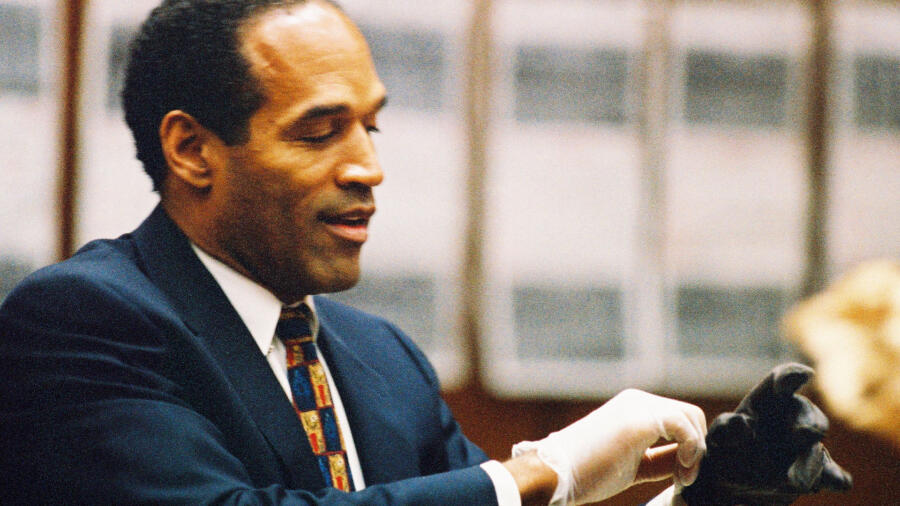They called it the Trial of the Century—and for good reason.
The O.J. Simpson murder trial captivated the world from the moment it began. From celebrity drama to high-stakes legal arguments, from live courtroom television to racial tensions that divided a nation, the trial became far more than a legal proceeding. It became a cultural flashpoint, forever reshaping how America views justice, media, and race.
Let’s revisit the most iconic and unforgettable moments from the O.J. Simpson murder trial, a case that blurred the line between courtroom and theater.
June 17, 1994: The White Bronco Chase Grips the Nation
Before the trial even began, the nation was glued to its TVs. After police issued an arrest warrant for O.J. Simpson, he failed to surrender. Instead, he fled in a white Ford Bronco driven by his friend, Al Cowlings.
With a gun to his own head and dozens of police cars in pursuit, Simpson rode down California’s I-5 freeway. Overhead, news helicopters captured every second of the surreal chase. Crowds gathered on overpasses, holding signs of support and shock. NBC even cut away from the NBA Finals to broadcast the event live.
This was more than an arrest—it was a spectacle. And it set the tone for everything that followed in the O.J. Simpson murder trial.
January 24, 1995: The Trial Officially Begins
The criminal case started with immense public interest. O.J. Simpson wasn’t just a retired football star—he was a beloved commercial icon and actor. But the prosecution, led by Marcia Clark and Christopher Darden, aimed to show another side: that of an abuser, manipulator, and killer.
With intense media coverage, every detail of the case played out live on national television—a first in American legal history.
February 3, 1995: Denise Brown Testifies About Domestic Abuse
One of the prosecution’s first emotional gut punches came from Denise Brown, Nicole Brown Simpson’s sister. Her voice cracking and eyes filled with tears, she described years of abuse her sister suffered at O.J.’s hands.
She told the jury, “He picked her up and threw her against the wall. He picked her up and threw her out of the house.”
Wearing angel earrings in Nicole’s memory, Denise humanized the victim—and revealed the dark, violent undercurrent of Simpson’s marriage.
June 15, 1995: O.J. Simpson Tries on the Gloves
In a moment that would become the trial’s most famous scene, O.J. Simpson tried on a pair of leather gloves allegedly worn during the murders.
Prosecutors believed they had the physical link that tied him directly to the crime. But in court, Simpson dramatically struggled to fit the gloves over his hands. He flexed, winced, and showed the jury how tight they felt.
Defense attorney Johnnie Cochran seized the moment with a phrase that still echoes in pop culture:
“If it doesn’t fit, you must acquit.”
The move backfired on the prosecution. The gloves didn’t appear to fit, and the jury took notice. Later, jurors admitted the moment swayed them. Some even called it the turning point of the trial.
August 29, 1995: Tapes Reveal LAPD Detective Mark Fuhrman’s Racism
The defense’s strongest argument centered on police misconduct. And when tapes surfaced of Detective Mark Fuhrman—a key investigator—using racial slurs and describing police brutality, the damage was irreversible.
Fuhrman had denied under oath that he used the N-word. But on tape, he used it dozens of times, bragged about assaulting Black suspects, and discussed fabricating evidence.
When brought back to the stand, Fuhrman pleaded the Fifth Amendment, refusing to answer questions about whether he planted evidence.
In a trial where race already loomed large, Fuhrman’s exposure shattered the prosecution’s credibility—especially among Black jurors, many of whom were already distrustful of the LAPD following the Rodney King beating in 1991.
October 3, 1995: The Not Guilty Verdict
After more than eight months of testimony, the jury returned a verdict in under four hours: Not Guilty.
Simpson mouthed the words “thank you” and smiled. One juror raised a Black Power fist—a powerful symbol in a case charged with racial tension.
Polls taken immediately after the verdict showed a stark racial divide:
- Majority of white Americans believed Simpson was guilty.
- Majority of Black Americans believed he was innocent or framed.
For some, the verdict represented a long-overdue rebuke of a biased criminal justice system. For others, it was a devastating miscarriage of justice.
Post-Trial: Civil Liability and Prison Time
Though he avoided prison in 1995, O.J. Simpson’s legal battles didn’t end.
- In 1997, a civil court found Simpson liable for the wrongful deaths of Nicole Brown Simpson and Ronald Goldman. He was ordered to pay $33.5 million in damages.
- In 2008, he was convicted of armed robbery and kidnapping in Las Vegas and served nine years in prison.
- In 2024, Simpson died at the age of 76, still maintaining his innocence.
The O.J. Simpson murder trial remained a defining moment of his legacy—and a turning point in American legal culture.
FAQs: O.J. Simpson Murder Trial
Why was O.J. Simpson tried for murder?
He was accused of killing his ex-wife Nicole Brown Simpson and her friend Ronald Goldman in 1994.
What was the significance of the gloves?
The prosecution believed the gloves connected Simpson to the crime. But when he tried them on and they didn’t fit, it raised doubt.
Who was Mark Fuhrman, and why was he controversial?
Fuhrman was an LAPD detective whose racist statements, caught on tape, severely undermined the prosecution’s credibility.
How long did the trial last?
The criminal trial lasted over eight months, but the jury deliberated for less than four hours.
Was O.J. ever punished for the murders?
Not criminally, but he was held liable in a civil trial and ordered to pay millions in damages.
Why did the case divide the nation?
Because it touched on race, celebrity, domestic violence, and police misconduct—all deeply emotional and societal issues in the U.S.

